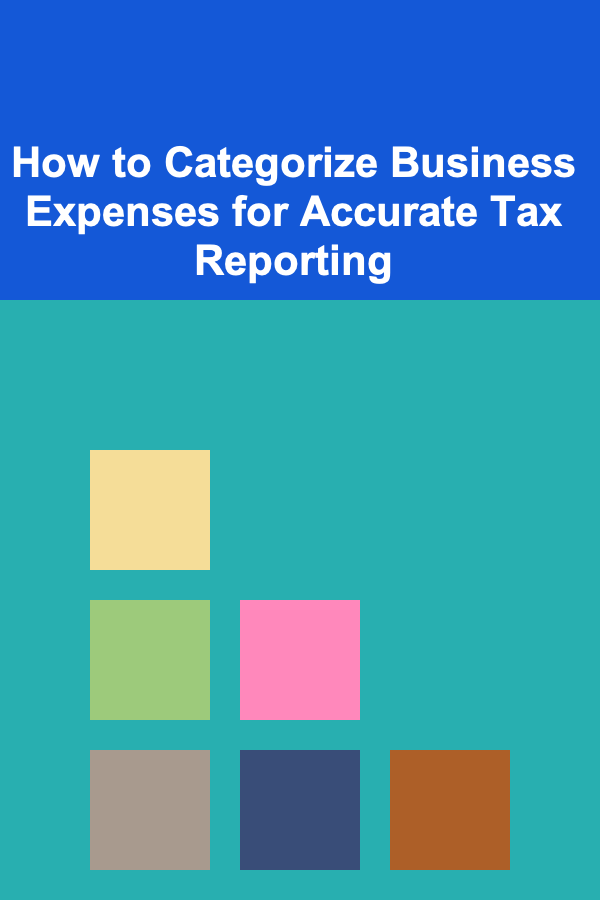
How to Categorize Business Expenses for Accurate Tax Reporting
ebook include PDF & Audio bundle (Micro Guide)
$12.99$10.99
Limited Time Offer! Order within the next:

Accurate tax reporting is crucial for the success of any business, whether it is a small start-up or a large corporation. Properly categorizing business expenses is a fundamental part of this process. Not only does it ensure compliance with tax laws, but it can also provide valuable insights into the financial health of your business. In this article, we will explore how to categorize business expenses for accurate tax reporting, helping you to minimize tax liability and avoid potential audit issues.
Understanding Business Expenses
Before diving into how to categorize expenses, it's important to first understand what constitutes a business expense. In simple terms, business expenses are the costs incurred during the normal course of business operations. These expenses are necessary for producing income and are therefore deductible from your business's revenue when calculating taxable income.
Types of Business Expenses
There are two primary categories of business expenses:
- Operating Expenses: These are the day-to-day costs of running your business, including rent, utilities, and wages. These are the most common types of expenses businesses face.
- Capital Expenses: These are long-term investments made in the business, such as purchasing equipment, buildings, or vehicles. These expenses are usually depreciated over time rather than deducted in full in the year they are incurred.
Classifying Business Expenses
To maintain accurate financial records and simplify tax reporting, business expenses must be classified into appropriate categories. The Internal Revenue Service (IRS) provides specific guidelines for categorizing business expenses for tax purposes. Below are some of the common expense categories:
1. Cost of Goods Sold (COGS)
The Cost of Goods Sold refers to the direct costs of producing the goods or services sold by your business. For a manufacturing business, this includes raw materials, labor, and overhead costs directly associated with production. For a retail business, it includes the cost of the products purchased for resale.
Examples of COGS:
- Raw materials
- Factory labor costs
- Product packaging
- Inventory purchased for resale
2. Rent and Lease Expenses
If your business rents or leases space for its operations, these expenses must be categorized as rent and lease expenses. This includes payments for office space, retail space, warehouses, or equipment leases.
Examples of rent and lease expenses:
- Monthly rent payments for office space
- Leasing fees for equipment or machinery
3. Utilities and Office Supplies
Utilities refer to the essential services your business needs to operate, such as electricity, water, gas, internet, and phone services. Office supplies include items such as paper, pens, printer ink, and other materials used in the office for day-to-day activities.
Examples of utilities and office supplies:
- Electric bills
- Internet and phone bills
- Printer paper, pens, and notebooks
4. Employee Salaries and Benefits
Salaries, wages, and other employee-related expenses are typically categorized under payroll expenses. This category includes not only direct compensation but also any benefits provided to employees, such as health insurance, retirement contributions, bonuses, and commissions.
Examples of payroll expenses:
- Salaries and wages
- Health insurance premiums
- Retirement plan contributions
- Employee bonuses and commissions
5. Advertising and Marketing Expenses
Advertising and marketing expenses are incurred when promoting your business, products, or services. These can be both digital and traditional marketing efforts, including online ads, print ads, or promotional events.
Examples of advertising and marketing expenses:
- Google Ads or Facebook Ads
- Website development and maintenance costs
- Print advertising (magazines, newspapers)
- Promotional materials (flyers, brochures)
6. Professional Services Fees
If your business engages external professionals such as accountants, lawyers, consultants, or any other service providers, these fees should be categorized under professional services.
Examples of professional services fees:
- Legal fees for contract review or litigation
- Accounting and bookkeeping services
- Consultant fees for business strategies or operations
7. Travel and Meals
Travel and meal expenses are incurred when employees or business owners travel for work-related purposes. These expenses are typically deductible if they are directly related to business operations, such as attending conferences, meeting clients, or making sales.
Examples of travel and meal expenses:
- Airline tickets, hotels, and car rentals for business travel
- Meals during business meetings
- Mileage for personal vehicles used for business purposes
8. Depreciation and Amortization
When you purchase significant assets for the business (such as property, equipment, or vehicles), you cannot deduct the entire cost in the year of purchase. Instead, these assets are depreciated over their useful life. This depreciation is deducted from your taxable income each year, thus reducing tax liability.
Amortization applies to intangible assets, such as patents or trademarks, which are gradually deducted over time.
Examples of depreciation and amortization:
- Depreciation of office furniture
- Amortization of software licenses
- Depreciation of vehicles used in business operations
9. Insurance Expenses
Business insurance, including general liability insurance, property insurance, and workers' compensation insurance, is a necessary cost for protecting the business against risks. These costs should be categorized as insurance expenses.
Examples of insurance expenses:
- Business property insurance
- General liability insurance premiums
- Workers' compensation insurance
10. Interest Expense
If your business has taken out loans or has outstanding credit lines, the interest payments on these debts should be categorized under interest expenses. This includes interest on business loans, credit cards, or lines of credit.
Examples of interest expenses:
- Interest payments on business loans
- Interest on credit card balances used for business purposes
Using Accounting Software for Accurate Categorization
One of the most effective ways to categorize business expenses for tax reporting is to use accounting software. These tools help automate the categorization process and ensure that your expenses are properly classified.
Popular accounting software options include:
- QuickBooks: A widely used platform that can track income and expenses, generate financial reports, and categorize expenses automatically.
- Xero: Another cloud-based accounting software that offers similar features, including expense tracking, invoicing, and tax reporting.
- Wave: A free accounting software that offers expense categorization, invoicing, and accounting features for small businesses.
These tools typically allow you to create categories for different types of expenses and track them throughout the year. They also generate reports that can simplify tax preparation by automatically pulling data for tax filings.
Tax Deductions and Business Expenses
Properly categorizing your business expenses is critical for maximizing your tax deductions. Certain expenses are fully deductible, while others may be partially deductible. Some common deductions include:
- Home office deduction: If you use part of your home for business, you may be able to deduct a portion of your rent, utilities, and other home-related expenses.
- Self-employment tax deduction: Self-employed individuals can deduct half of their self-employment tax.
- Health insurance premiums: Business owners who are self-employed may be able to deduct the cost of health insurance premiums.
It's important to consult with a tax professional to ensure you are fully compliant and taking advantage of all available tax deductions.
Tracking Expenses Throughout the Year
To ensure accurate categorization and tax reporting, it's essential to track your business expenses regularly. Waiting until the end of the year to categorize your expenses can lead to errors or missed deductions. Here are a few tips for keeping track:
- Create a system: Develop a consistent system for recording all expenses, whether it's using accounting software, spreadsheets, or manual records.
- Keep receipts: Always keep receipts for any business expenses, as they may be required for tax reporting and potential audits.
- Review expenses monthly: Set aside time each month to review and categorize your expenses, ensuring that everything is in order and you're not missing any potential deductions.
Consulting a Tax Professional
While categorizing your business expenses may seem straightforward, it can be a complex process depending on the nature of your business and the tax laws in your country. Consulting with a tax professional or accountant can provide peace of mind and ensure that your tax reporting is accurate.
Tax professionals can help you:
- Maximize deductions and minimize liability
- Identify potential tax-saving strategies
- Ensure compliance with local, state, and federal tax laws
- Assist with year-end tax preparation and filing
Conclusion
Categorizing business expenses is an essential task for accurate tax reporting. By properly classifying your expenses and tracking them consistently throughout the year, you can reduce your tax liability, ensure compliance, and gain a better understanding of your business's financial health. Whether you use accounting software or manual methods, the key is to stay organized and seek professional advice when needed. Proper expense categorization can save you time, money, and stress when tax season comes around.
Reading More From Our Other Websites
- [Home Rental Property 101] How to Screen Potential Tenants Using Credit and Background Checks
- [Home Space Saving 101] How to Incorporate Furniture with Built-In Storage into Your Home Design
- [Home Cleaning 101] How to Organize and Clean Your Garage in One Weekend
- [Personal Care Tips 101] How to Care for Mature Skin with the Right Products and Routine
- [Home Staging 101] How to Launch Your Own Successful Home Staging Franchise and Build a Thriving Business
- [Needle Felting Tip 101] Step-by-Step Guide: Needle-Felt Your Own Plush Dog
- [Home Budget 101] How to Set Smart Financial Goals for Families and Achieve Them Together
- [Trail Running Tip 101] Safety First: Navigating Trail Hazards When You're Running or Hiking
- [Organization Tip 101] How to Use Shelf Risers for Better Kitchen Organization
- [Beachcombing Tip 101] From Shells to Seaweed: A Beginner's Guide to Identifying Beach Flora and Fauna

How to Organize Your Phone Chargers and Cables
Read More
Strategizing Growth: A Business Development Manager's Guide to Strategic Partnerships
Read More
How to Identify the Influence of Terroir on Wine
Read More
Controlling Your Data in Smart Healthcare Systems
Read More
Applying Stoicism to Manage Anxiety
Read More
How to Use Financial Calculators Effectively
Read MoreOther Products

How to Organize Your Phone Chargers and Cables
Read More
Strategizing Growth: A Business Development Manager's Guide to Strategic Partnerships
Read More
How to Identify the Influence of Terroir on Wine
Read More
Controlling Your Data in Smart Healthcare Systems
Read More
Applying Stoicism to Manage Anxiety
Read More